
Ex OnePlus co-founder, Carl Pei’s new venture dubbed “Nothing” has generated quite a bit of buzz in the tech community. The company’s mission is to remove the barriers between people and technology, and the first product from the newly-founded company is the Nothing Ear 1. The device has caused a stir in the market due to its unique transparent design. Launched on July 27, the Nothing Ear 1’s design has been a talking point amongst enthusiasts since many expected the buds to have a completely transparent design, as indicated by the Concept design Nothing shared, which people believed to be the final product. The design on the final product is actually semi-transparent with the stem part of the earbuds being transparent instead of the whole earbud. The design language is meant to set itself apart from the sea of similar-looking TWS flooding the market. Priced at Rs 5,999, the Nothing Ear 1 looks like an enticing offering since it features a unique design and some premium features such as Active Noise Cancellation. All without breaking the bank. So, let’s put the Nothing Ear 1 through its paces and find out if these earbuds are worth the hype, and your money.
Nothing Ear 1: Specifications
The Nothing Ear 1 sports an 11.6mm dynamic driver and features the latest Bluetooth 5.2 connectivity with support for SBC and AAC audio codecs. The earbuds are tuned with the help of Swedish consumer electronics company Teenage Engineering. The charging case and the earbuds feature a semi-transparent design that allows users to peek at some of the components inside the earphones. Each earbud weighs merely 4.7g while the charging case weighs 57.4g.
The buds come with support for Active Noise Cancellation for when you want to be cocooned in an auditory bubble and Transparency Mode for when you want to hear your surroundings. The Ear 1 also comes with Clear Voice Technology backed by a triple microphone setup.
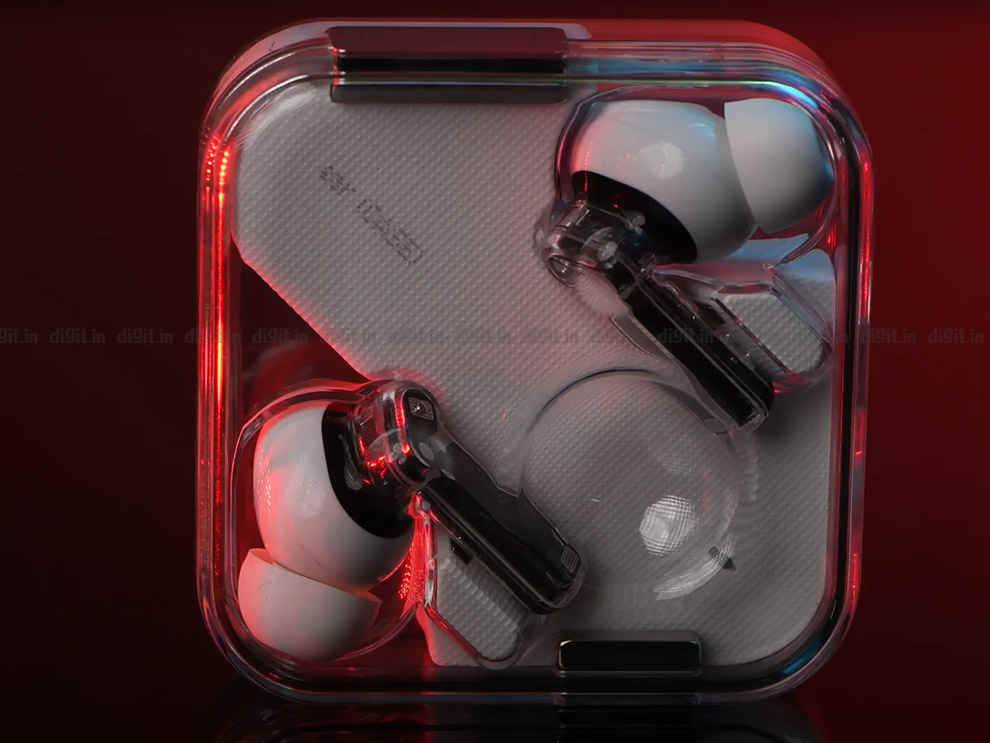
As for battery life, the Nothing Ear 1 comes with a playtime of 5.7 hours on the buds alone without ANC on, and 4 hours with ANC on. Total playback along with the charging case, without ANC turned on stands at 34 hours, and with ANC turned on is 24 hours. The buds also have fast charging support where 10 minutes of charging the device will net users 1.2 hours of playback with ANC on, and 50 minutes of playback with ANC turned off. Additionally, the case can be charged up wirelessly on any Qi certified wireless charger.
The buds come with app support that allows users to tweak some settings. The app has the same name as the earbuds – Ear 1 and is available for both Android and iOS devices. Lastly, the buds come with IPX4 splash resistance.
Nothing Ear 1: Build and comfort
If you’re looking for a pair of truly wireless earbuds that stand out from the crowd, the Nothing Ear 1 does that exceedingly well. Despite not sporting the fully transparent design that was showcased as a concept, the semi-transparent buds definitely don’t look like others on the market, at this price point. Right from the moment you set your eyes on the charging case, scratch that, the box, the difference is tangible.
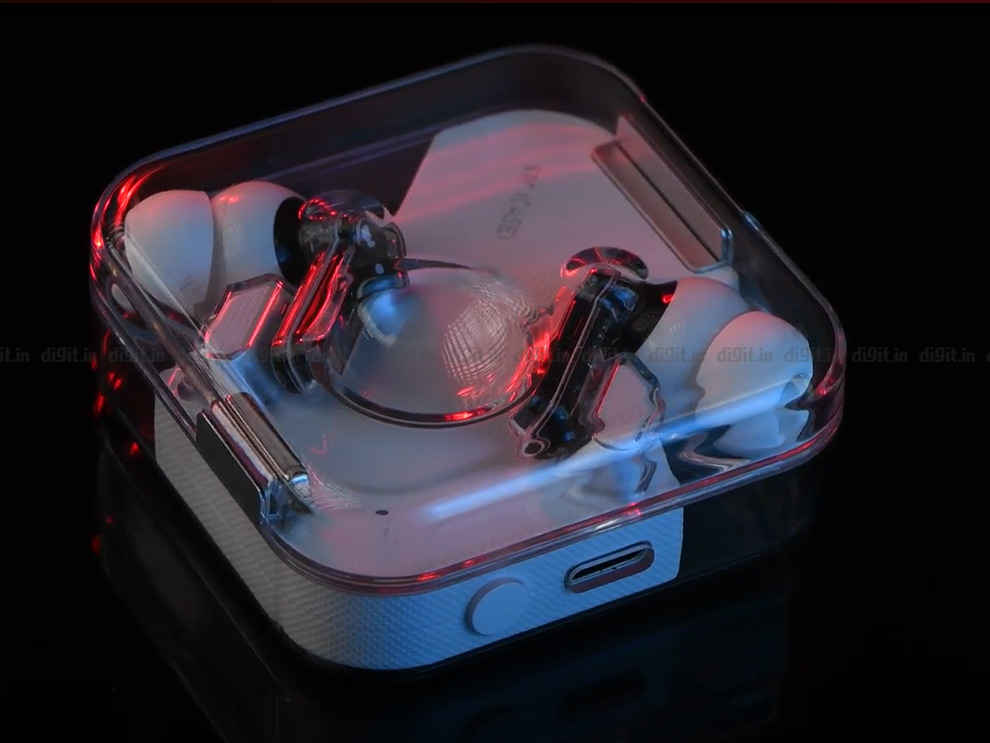
The transparent body of the case, while made out of plastic, looks deceptively like glass and Nothing claims that the material won’t degrade or turn yellow over time. The transparent case allows you to glance at the earbuds inside, as well as the tiny battery indicator LED light with it still being closed. The earbuds and the case are graced with a font that you’ll likely not find on any other earbuds’ box, and the whole design language is a gorgeous fusion between industrial and elegance.
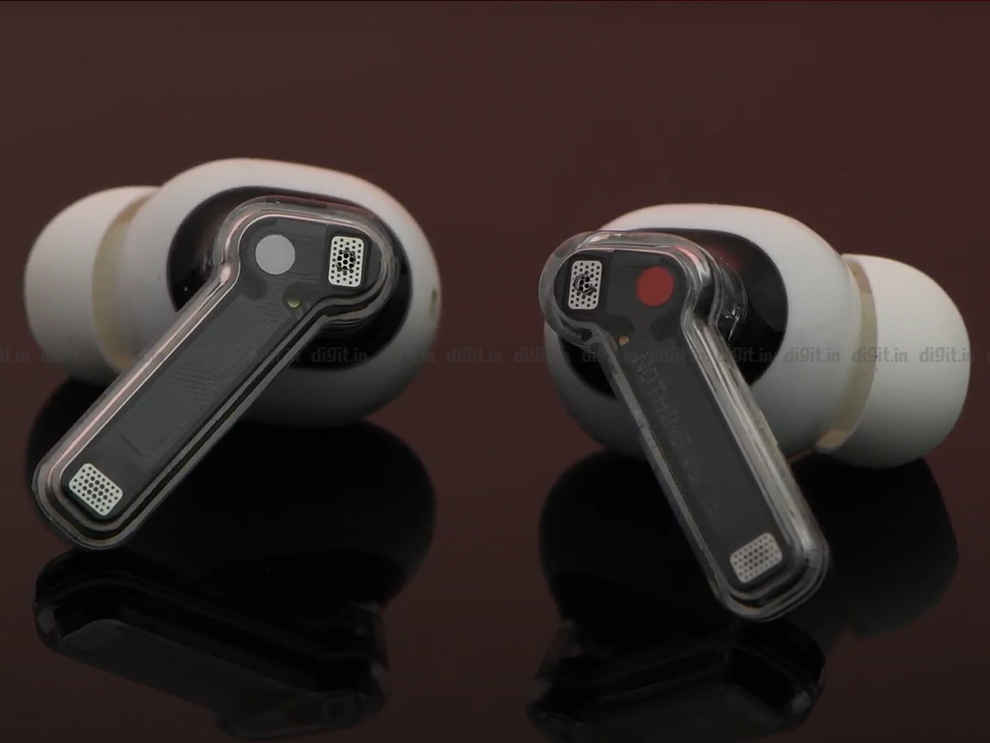
The earbuds, while not completely transparent, look extremely interesting. The stem portion of the buds is transparent and you can see a considerable number of components within the buds including the microphones, magnets, and even some silicone. The top half of the buds feature a regular white angled nozzle with a silicone ear tip sitting on the top. We have reviewed a pair of transparent IEMs before called the Shure Aonic 5, but those are exorbitantly priced at Rs 42,999, so it’s impressive to see a similar design on a TWS priced at Rs 5,999.
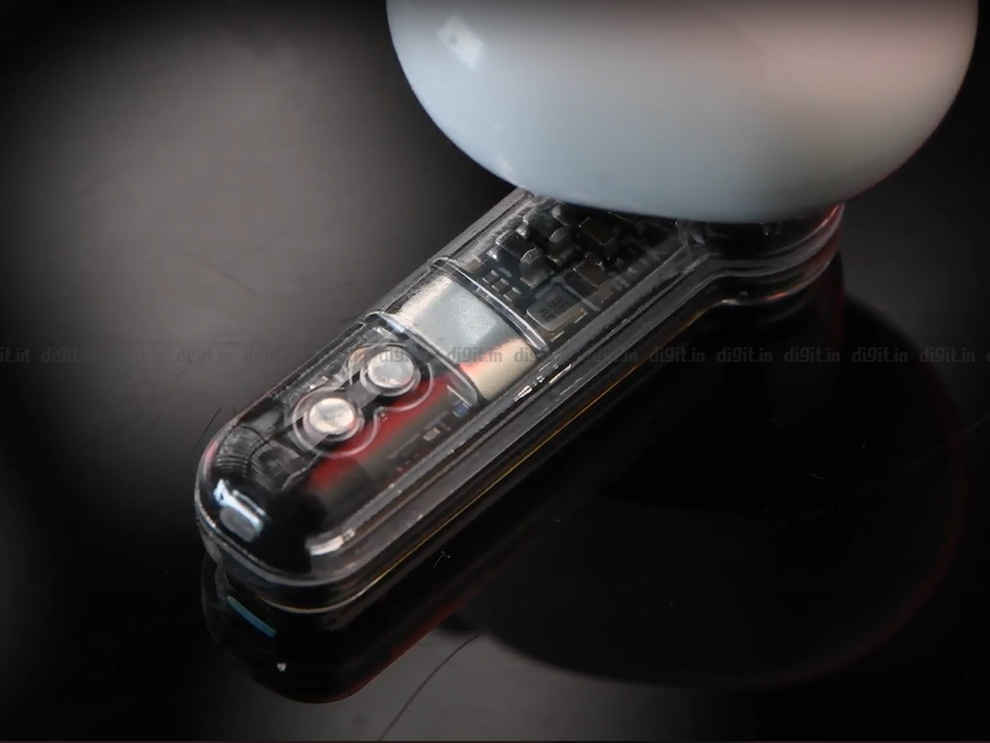
The charging case houses the USB-C charging port and the pairing button on the right side and a pretty sizable indent on the top of the case to assist with opening it up. The case can also be opened one-handed, however, it isn’t very easy to do so. Some muscle memory should make opening the case one-handed easier over time.
The case houses strong magnets to hold the earbuds and they don’t fall out of the box even if you violently jerk it around, which is reassuring. The case shuts close with an audible, satisfying snap, which we love. It is also a pretty pocketable case due to its flat design, although if you are wearing skinny jeans, the case may bulge out slightly.
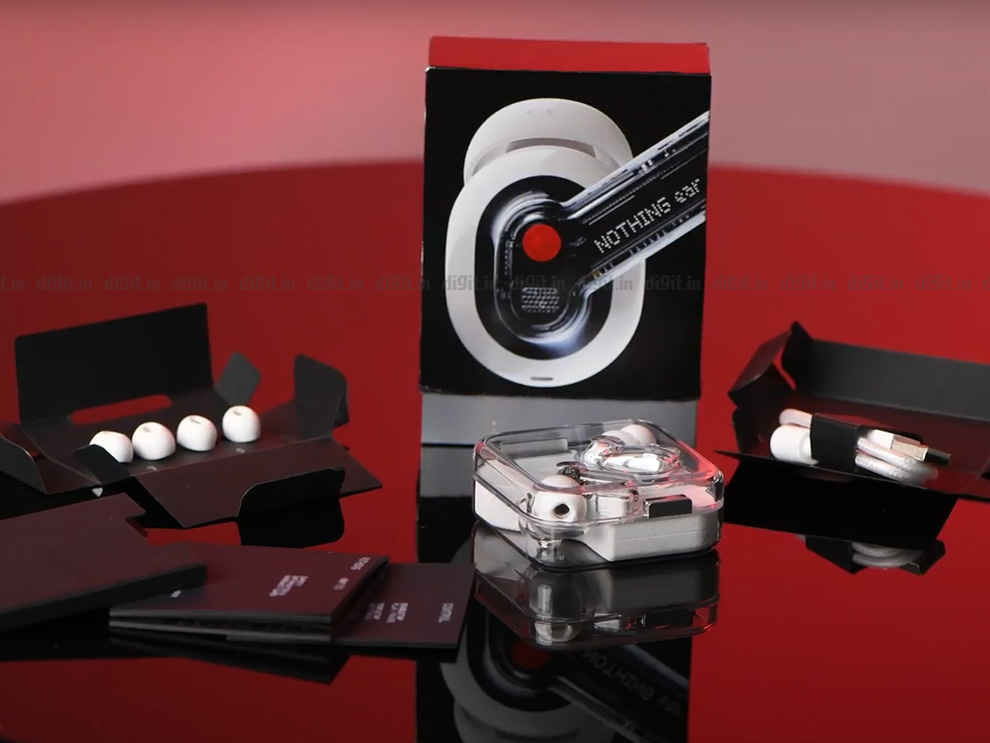
Moving on to the fit and comfort of the Nothing Ear 1, the earbuds twist and lock securely in place and create a very snug and comfortable fit for the most part. The company has provided two extra sizes of silicone ear tips in the box, so it should fit most ears. The fit is extremely secure and doesn’t budge in the slightest even when moving your head about frantically. It’s safe to say that the buds will remain in place even during intensive workouts or while running. Additionally, the IPX4 rating ensures that the earbuds can shrug off sweat and light splashes as well, so you don’t need to worry about liquid damage from sweat or light rains.
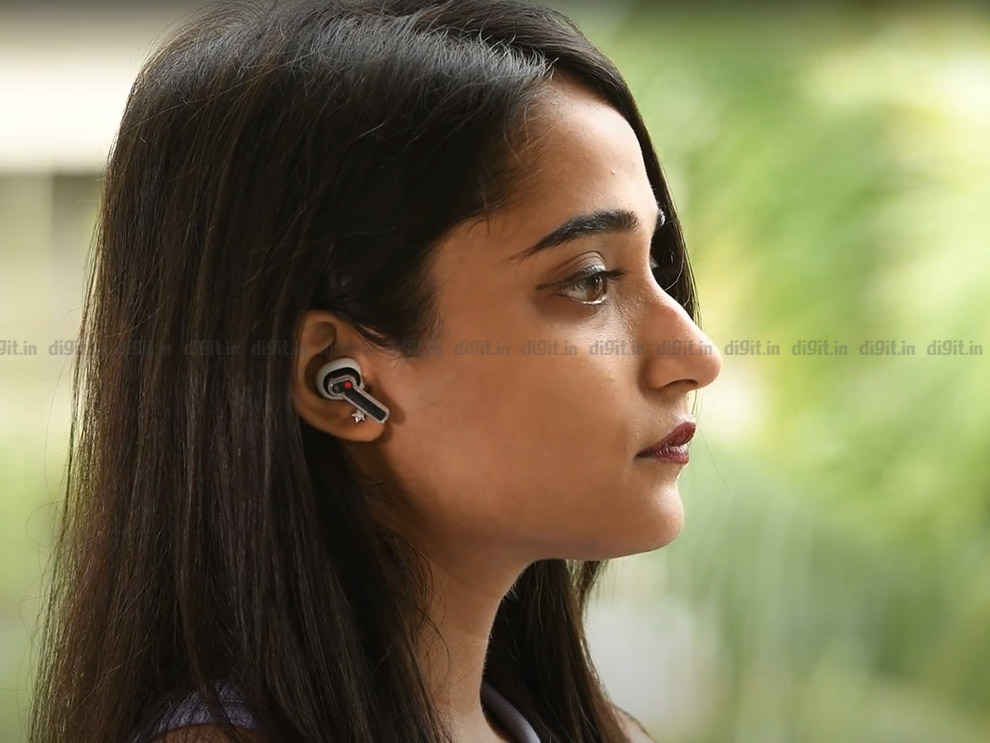
The Nothing Ear 1 earbuds are also pretty comfortable to wear over extended periods of time. The angled nozzles of the earbud sit snugly in the ear and there isn’t too much strain to one’s ear when wearing these. We tested out these earphones for hours on end and only found our inner ear getting slightly sore after about 2-3 hours of continuous listening, which is pretty good. The back of the earbuds’ stems house touch controls for various actions. The touch panel was adequately responsive and fairly accurate during our testing process.
Nothing Ear 1: Active Noise Cancellation, Ear 1 App and other features
The Nothing Ear 1 is a pretty feature-laden pair of true wireless earphones under 6K. Not only does the Nothing Ear 1 come equipped with Active Noise Cancellation, it also has a plethora of other features. Let’s start with the headlining feature Active Noise Cancellation or ANC. The Nothing Ear 1 sports two modes of ANC – Light and Maximum that you can toggle between via the accompanying Ear 1 app. The former is good for times when you want a level of isolation that’s immersive, but not all-encompassing, while the latter blocks out considerably more ambient noise.
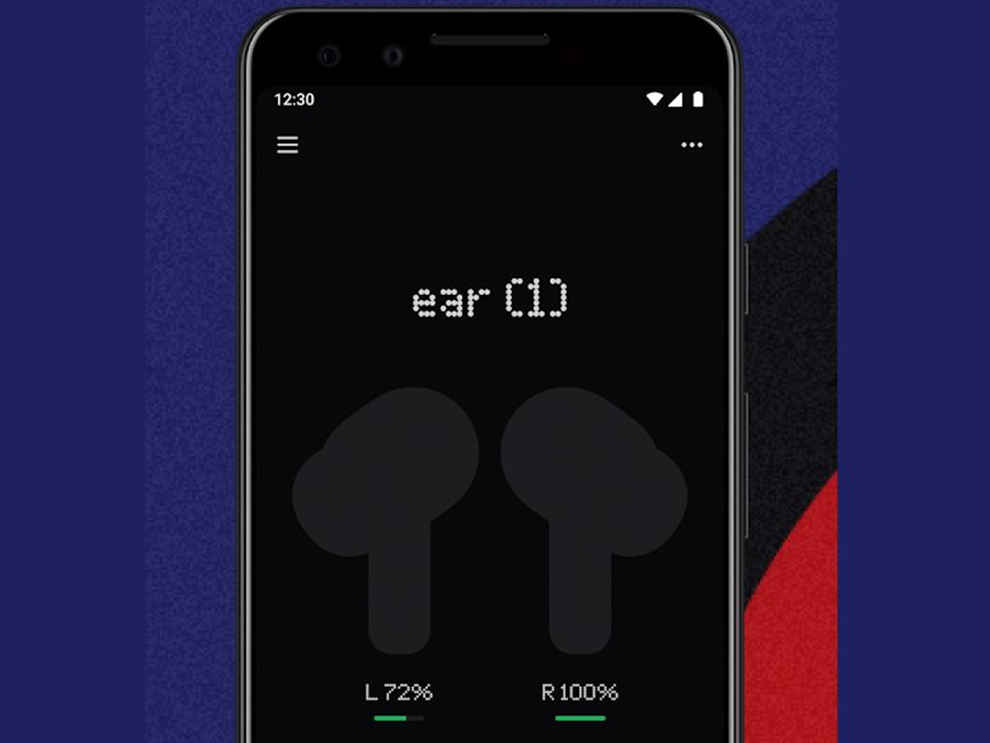
At Maximum ANC mode, the Nothing Ear 1 does a fairly good job at blocking out low-end, constant ambient sounds such as the hum of an AC, the drone of an airplane, and more. It will not drown out higher-pitch or erratic sounds such as a high-speed fan, typing on a mechanical keyboard and some human voices. This is fairly common at this price point, and Nothing has done a pretty good job implementing ANC into its first-gen product.
The device also comes with Transparent Mode that amplifies ambient noise, so you can hear your surroundings while listening to music. This helps in situations where you want to be aware of your surroundings such as a road with traffic or a train station / airport with important announcements. Transparent Mode on these earbuds is slightly erratic. At one moment you will hear the ambient noises clearly and suddenly the levels of ambient noise will drop to something more akin to normal mode with no ANC. With the latest firmware update, some of these issues with Transparency Mode are less pronounced.
Speaking of firmware updates, we experienced an issue in the app where no matter the number of times we performed a firmware update, it kept showing us that the same update was ready to be installed again. We spoke to Nothing about this issue and they provided us with an APK to update to the latest firmware. The issues with Transparency Mode and the firmware updates seem to be sorted out with this update.
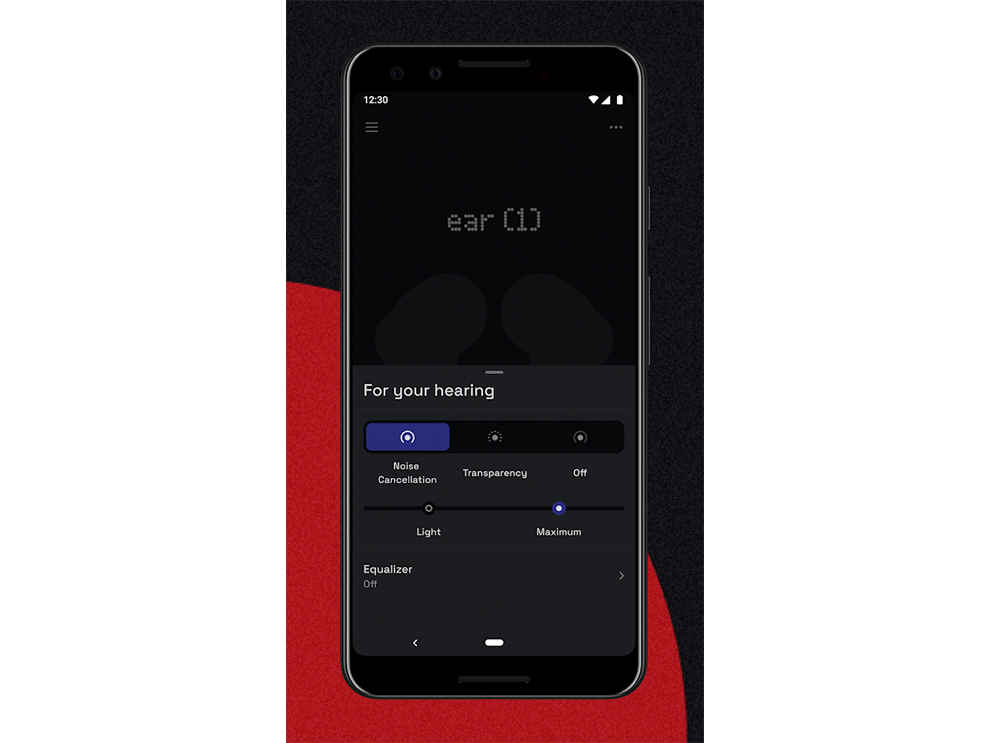
ANC and Transparency Mode aside, you have the Ear 1 app, available on both Android and iOS, that allows users to tweak some settings on these earbuds. The app does basic things such as display the battery percentage remaining on your earbuds and the charging case. It can also be used to customise the touch controls, although the options are fairly limited here. By default, the touch controls are set to pause/play music with a double tap, skip to the track with a triple tap and switch between noise cancellation modes with a touch and hold.
In the app, you cannot customise the function of a double tap, but you can change the triple tap function to next song, previous song or no action at all. You can also choose to have no action assigned to the touch and hold command instead of noise cancellation, but that’s about it. To control the volume, you can slide your finger up and down the stem to increase or decrease volume respectively, which is pretty neat. However, there’s no voice assistant command on these buds which is frankly, baffling, seeing that some TWS under 2K also implement this feature. All in all, even though we do have customisable touch controls via the app, there’s not much you can do with them at this moment.
Apart from touch controls, you can also switch between noise cancellation profiles within the Ear 1 app and choose between four preset EQ settings – Balanced, More Treble, More Bass, and Voice. We found the Balanced EQ to be the most, well… balanced sound profile across genres, however, you can change the EQ settings as per your preference. There’s no custom EQ setting, but owing to its low price point, we don’t really expect one.
The Ear 1 app also allows users to change themes with dark mode turned on by default (nice!), customise the case’s LED light, perform firmware updates, find your earbuds in a pinch if you’ve misplaced them and toggle in-ear detection. In-ear detection uses sensors within the earbuds to pause the music automatically when removed from the ear, and play it when reinserted in the ear. This worked okay, for the most part, however, there was a slight delay between removing the buds and the music actually pausing.
The Nothing Ear 1 also comes with other features such as Mono earbud use where both earbuds act as masters and can be used independently of each other, there’s Qi wireless charging support and Fast Pairing as well. Overall, they are a feature-rich pair of earphones, although we really missed having voice assistant support on these buds.
Nothing Ear 1: Performance
As mentioned before, the Nothing Ear 1 sports an 11.6mm dynamic driver and is tuned with the help of Teenage Engineering. It supports SBC and AAC codecs, and while we wish the earbuds had support for more advanced codecs, it is understandable to give it a miss to keep the price affordable. For a single-driver setup, these earbuds sport a pretty decent sound signature. The buds have a V-shaped sound signature where the lows and highs are slightly accentuated in comparison to the mids.
For objective testing, we use a product from a measurement mic from SLS Audio (Denmark), which is made to test earphones. For our Audio interface device, we use the Focusrite Scarlett 2i2. This is all hooked up to a PC running the SMAART-Di v2 software, which allows us to generate frequency response graphs for headphones that will ultimately indicate their sound signature.
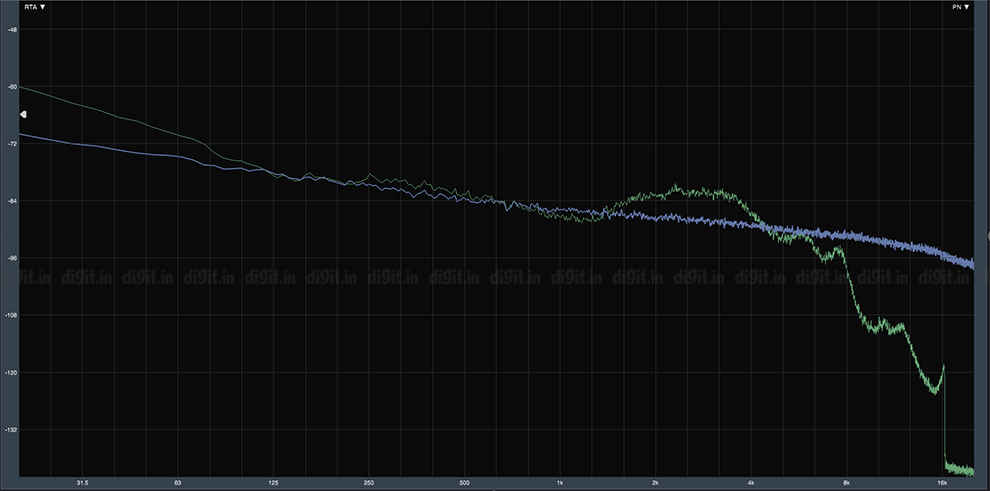
Uncompensated frequency response of Nothing Ear 1 (Light Green) vs Flat Response (Light Blue)
In the uncompensated frequency response graph generated, you can see that the lows from 20 Hz to about 100 Hz are exaggerated, creating a bass rich experience. Despite the exaggeration, the bass is tuned well and didn’t sound muddy or boomy at any point. The mids are mostly in line with the ideal flat response, however, the exaggerated bass response can cause some auditory masking in the mids. Therefore, when you listen to songs with a lot of bass, vocals and lead instruments sometimes sound slightly veiled.
There is a peak in the frequency response graph from 1K Hz to 4K Hz that means the highs stand out prominently in the mix, although there is a dip off past 8K Hz which may obscure some detail since the human hearing can reach up to 20kHz. The peak at 1-4K causes some shrillness in the highs if you listen at loud volumes levels, so keep that in mind.
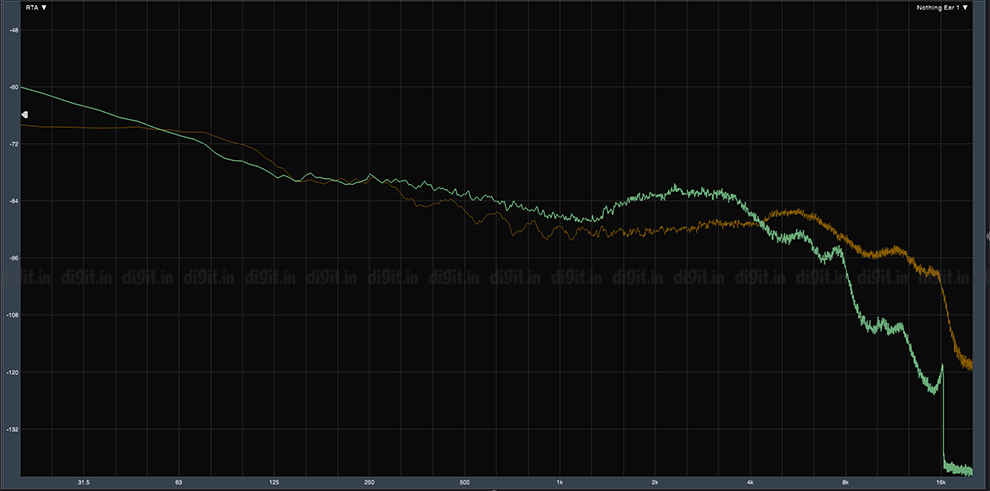
Uncompensated frequency response of Nothing Ear 1 (Light Green) vs Reference IEM (Orange)
The Nothing Ear 1 has a fairly pleasing sound signature that works well with genres such as pop, rap, EDM, hip hop, Bollywood, and even rock, to some extent. The close to neutral mids frequency response works well when you listen to podcasts as well. Overall, at under 6K, the Nothing Ear 1 is one of the better sounding TWS we’ve heard. The bass response has punch but doesn’t sound muddy, the mids are clear and detailed but some from slight auditory masking from the bass, and the highs are decently reproduced.
The soundstage isn’t wide at all, but that’s expected with in-ear headphones, especially at this price, however, the imaging and positioning is pretty immaculate. There’s some distortion, especially in the highs, when you listen to these earbuds at over 90 percent volume, so try to use them at lower volumes. We found 60-70 per cent volume to be the sweet spot. Additionally, there’s very little difference in the sound signature with ANC turned on and off.
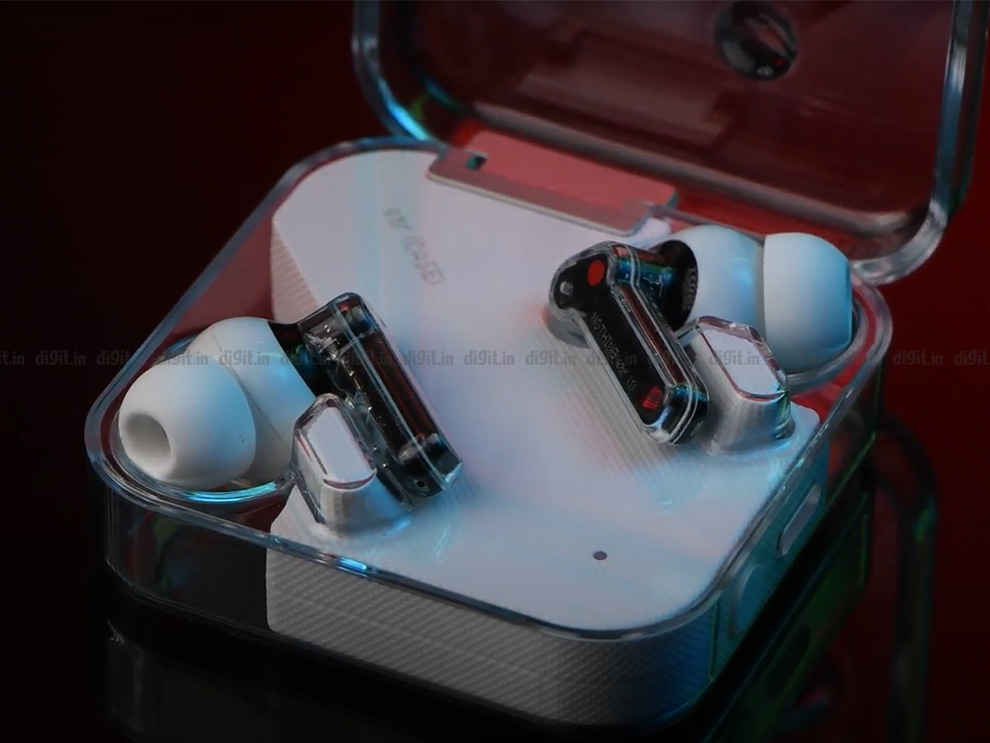
Moving on to the microphone, the Nothing Ear 1 features three high-definition microphones and comes with Clear Voice Technology that fires up algorithms to cancel out ambient sound when on calls. We found the microphones on these buds to be pretty decent, for the most part, however, if you’re in a windy area there may be some disturbance.
Finally, moving on to connectivity, the Nothing Ear 1 is powered by the latest Bluetooth version 5.2 and the connection was extremely solid during our testing process. We never experienced any sort of lags, skips or stutters in the connection. When watching videos on YouTube and Netflix or playing games such as Call of Duty Mobile, we experienced slight latency, however, it is barely noticeable. Additionally, the Bluetooth range is also pretty good. The company claims 33 feet of transmission range, without obstacles. In our testing, we found that you usually have to go pretty far for the connection to crack or drop at all.
Nothing Ear 1: Battery life
Finally, let’s move on to the battery life of the Nothing Ear 1. The company claims that the buds have a playtime of 5.7 hours on the buds and 34 hours in total with the charging case, without ANC turned on. If you do turn it on at all times, the company claims 4 hours of playtime on the buds alone, and 24 hours in total with the charging case.
We kept the ANC on at all times when we were testing battery life. In our tests, the buds lasted 3 hours and 40 minutes at 70 per cent volume. The charging case was able to top off the earbuds 5 times over before needing to be charged. The playtime on the buds alone is definitely on the lower side since inexpensive ANC buds like the Realme Buds Q2 also come with 5 hours of playtime with ANC on, which is significantly higher. Nevertheless, the total battery life of the earbuds along with the charging case is pretty good.
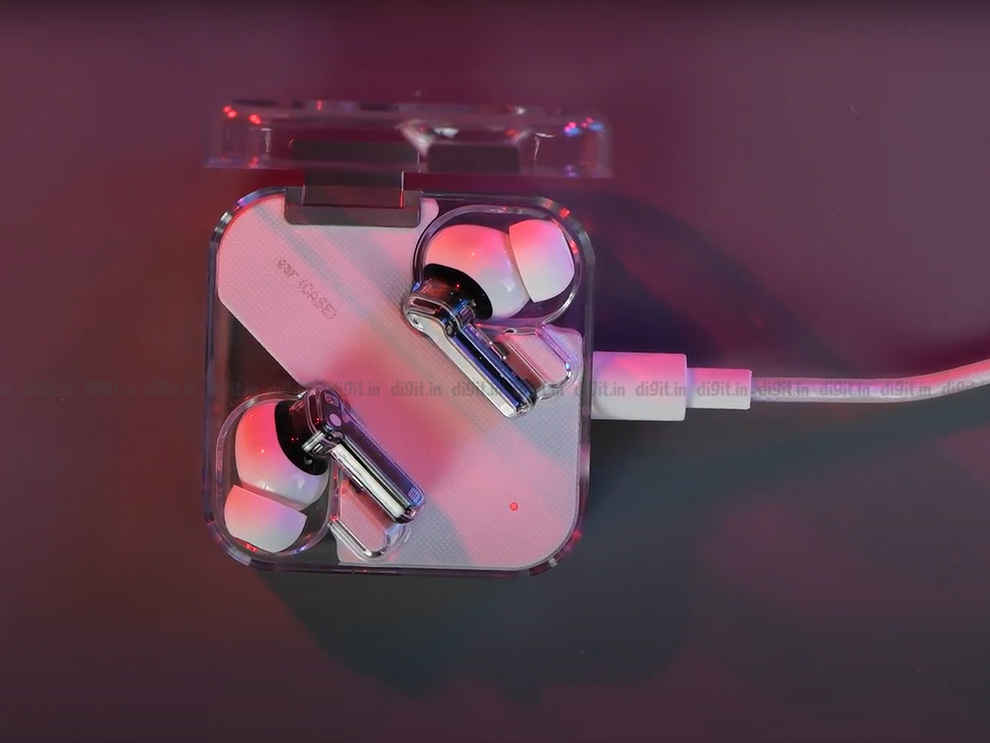
In our tests, the case charged up the earbuds from empty to full in a little over an hour. 10 minutes of charging gives you about 50 minutes of playtime with ANC turned on, which is again, slightly lacklustre.
What’s good here is Qi wireless charging support. If you have a wireless charger, or a phone with reverse wireless charging support, it is extremely convenient to simply plonk down the case on the pad without worrying about wires. It’s great to have wireless charging support at this price point, and it’s not something we see often in the budget to mid-range TWS segment.
Nothing Ear 1: Verdict
The Nothing Ear 1 is a true masterclass in design, especially when it comes to earphones that don’t burn a hole in your pocket. The transparent case and earbuds immediately stand out from the crowd and the earbuds are also pretty comfortable to wear over long periods. Priced under 6K, the Nothing Ear 1 is also a feature-packed pair of truly wireless earbuds, although there are some misses such as lack of voice assistant support and mediocre wear detection performance.
Despite these shortcomings, you get a pair of earphones that look absolutely breathtaking, have a decent total playback time and good sound. While the sound signature definitely won’t appease the purists or audiophiles out there, most people will enjoy the commercially tuned sound signature that highlights the bass and highs. If you’re scouring the market for an affordable pair of TWS earphones that stand out from the crowd when it comes to design and wow you with its feature-set, the Nothing Ear 1 gets our stamp of approval.
[ad_2]
Source link






